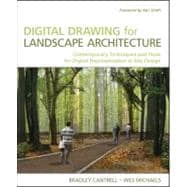A full-color guide to digital landscape representation
For a hundred years, pencil, pen, markers, and watercolor have been the principal tools of representation for landscape architects and urban planners. Today, those hand-powered aids have been replaced by computers and Computer-aided design (CAD). Digital Drawing for Landscape Architects bridges the gap between the traditional analog and the new digital tools and shows you how to apply timeless concepts of representation to enhance your design work in digital media.
Building on the tried-and-true principles of analog representation, Digital Drawing for Landscape Architecture explores specific techniques for creating landscape design digitally. It explains the similarities and differences between analog and digital rendering, and then walks you through the steps of creating digitally rendered plans, perspectives, and diagrams. You’ll explore:
-Computing Basics
-Raster and vector images
-Setting up the document
-Base imagery and scaling
-Hand-drawn linework and diagrams
-Text, leaders, and page layout
-Color, shading, and textures
-Creating a section elevation
-Perspective drawing
-Techniques for using the newest versions of Adobe Illustrator, Photoshop, and Acrobat as well as older versions
With more than 500 full-color drawings and photographs alongside proven techniques, Digital Drawing for Landscape Architects will help you enhance your skills though a unique marriage of contemporary methods with traditional rendering techniques.








